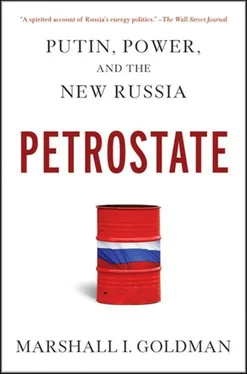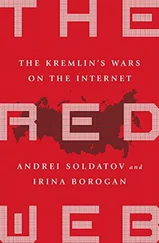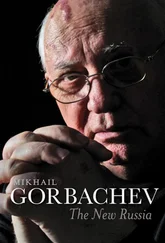TABLE 2.1 Petroleum Production (Crude)

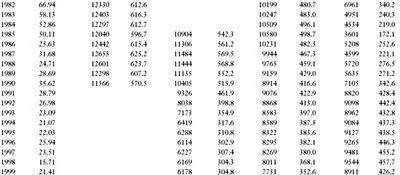
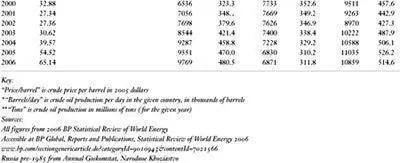
When output per well in the Volga-Ural region also began to fall, the slack was taken up by the opening of new areas in West Siberia. In contrast to the long period from 1929, when the first oil was struck, until the late 1940s, when production in the Volga-Ural region finally began to reach a meaningful level, the lag between discovery and production in West Siberia was much shorter. Although exploration for liquid energy in the region began before the Second World War, the first find occurred by accident in West Siberia in September 1953. 7A drilling team was delayed while sailing up the Ob River near the town of Berezov. On the spur of the moment they drilled a test well and found gas in what became the Berezovskoe gas field. It was seven more years, in 1960, however, before the first oil was discovered in a Jurassic zone near Shaim on the River Konda, a tributary of the Ob and Irtysh. The “super-giant” field in a Cretacean level at Samotlor, about 500 miles to the east, was discovered in 1965, and the first commercial-scale well was completed in April 1968. 8Whereas it took almost twenty years for the Volga-Ural fields to move from discovery to delivery to consumer, it took only eight years in the West Siberian Tiumen region. By 1970 production had reached 31 million tons; by 1975 it was 145 million tons; and in 1977, about 210 million tons. 9
Notice the pattern here. The output in West Siberia seemed to compensate for the drop in productivity in the Volga-Ural fields in the late 1960s and early 1970s, just as the output in the Volga-Ural regions, coming on line in the late 1940s and early 1950s, offset the declining output of Baku. So far, each time output in one major region slackened, the Soviets found a new region. It would be nice if Russian oil operators could continue in this leapfrog manner. The American geologist John Grace doubts that will happen, since most of the giant fields in Russia, at least those that are easily reachable in terms of production and transportation costs, have already been discovered. But this type of solution to their production problem also had a negative side. It postponed the time when the Soviets would have to face the need to use their resources more efficiently. This is important because outside analysts began to warn as early as 1977 that the Soviets would shortly run out of new fields to develop. In an April 1977 open report that made big headlines in the United States, the CIA predicted that without a substitute for water injection technology, Russia’s annual output would drop sharply in the Volga-Ural region. As the CIA saw it, by 1985 Russian oil output would fall off so sharply that the USSR would no longer have enough petroleum to export. In fact, it predicted that by the mid-1980s, the USSR and its East European allies would be forced to import 3.5 to 4.5 million barrels a day (175–225 million tons). As we shall see, the CIA’s predictions were wrong; none of that happened.
THE SOVIET PLANNING, PRODUCTION, AND INNOVATION SYSTEM
The Soviet planning and incentive system and the special peculiarities that affected the Soviet raw materials and petroleum industries all but guaranteed that the Soviets would have difficulty solving their efficiency and productivity problems. In fairness, it should be pointed out that an inability to manage innovation effectively was not an affliction brought on solely by the Russian Revolution. The revolution seems to have compounded the problem, but even before 1917, we saw when discussing drilling technology in Baku in the nineteenth and early twentieth centuries, Russia’s existing methods lagged behind developments in the West. Invariably it was necessary either to import more advanced technology or bring in foreigners to run actual concessions. 10Such lags were not necessarily characteristic of all pre-revolutionary and pre–Five Year Plan technology, but they were widespread enough to cause suspicion that something deeper than a poor incentive system was at fault. There are a number of explanations: Russia was too remote to be affected by the West European Renaissance, Napoleon never stayed in Russia long enough to bring with him the reforms of the French Revolution and their emphasis on scientific enlightenment and rationality, widespread literacy was lacking until midway into the twentieth century, and the oppressive legacy of authoritarian and rigid governments before and after the revolution discouraged initiative. A mixture of all these factors probably contributed to the problem. Whatever the exact explanation, there is no doubt that Russian culture and history combined with the Soviet system of central planning and a lack of economic incentives stifled creative thinking, at least in the economic and technology spheres.
The Soviet development of the turbo-drill illustrates how shortcomings in the Soviet process of producing, planning, and innovation affected the development of the Soviet petroleum industry. In a perceptive analysis, Robert Campbell of Indiana University explains why the innovation-shy Soviet petroleum engineers were nonetheless prodded into developing this unique process which could utilize lower quality steel pipe. 11To drill effectively using rotary drilling, the driller must have good-quality pipe that can withstand increasing tension and pressure as the drilling goes deeper. With poor-quality steel pipe, breakdowns, cracked pipe, and tool-joint failures are endemic. 12This means not only an increased need for replacement pipe but lost time spent on repairs and lifting and lowering the portions of the pipe string that remained intact. With the type of pipe available to the Soviets at the time, they could drill down only 2,000 meters. 13In 1950 that was the depth of almost 90 percent of Soviet wells. Though inefficient, it was adequate for the drillers in the Baku region. The Soviets were able to satisfy their needs, albeit with a good deal of waste.
While shallow wells may have been suitable for Baku, they were of no use in the producing fields in the Volga-Urals region where oil and gas deposits were much deeper. Furthermore, the use of the traditional rotary drill process with low-tensile-strength pipe meant that the drillers could reach the 2,000 meter depth only when the ground was soft and the rock not too hard. But as Campbell pointed out, Soviet drill pipe at best was made from what in the United States is considered unsatisfactory grade D and some higher grade E steel. 14In the United States, drillers restricted themselves to the use of grade E steel and pipe or even higher grades.
Why did the Soviet Union, as the world’s largest producer of steel, not produce higher quality steel? As long as the Soviet system placed stress on quantity rather than quality of production, the Soviet manager had little or no incentive to produce the higher grade steel. His pay depended not on producing high quality but on producing as much quantity as possible, usually measured by the weight of the steel. 15Generally, the Soviet manager was not concerned about whether his product was sought after in the marketplace. It was usually enough that his product was produced and transferred from the factory floor. Once that happened and a factory achieved its physical output plan targets, the workforce would then share in the enterprise bonuses.
Читать дальше
